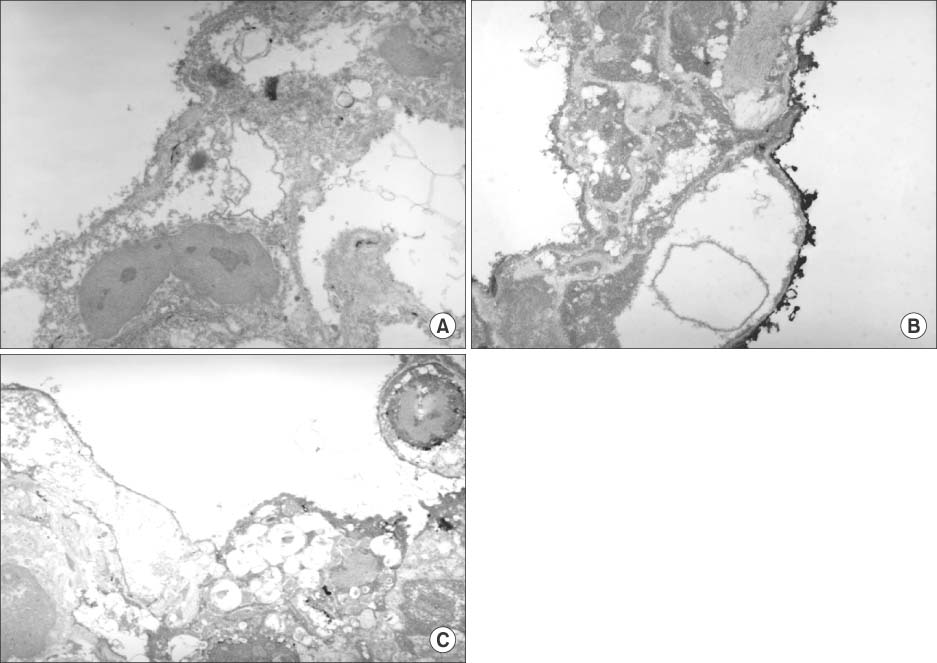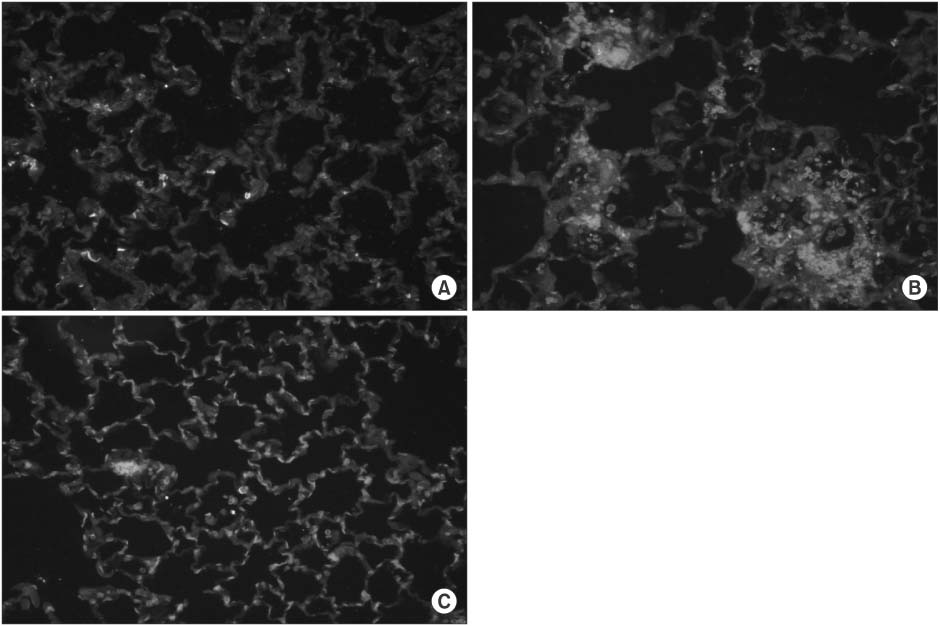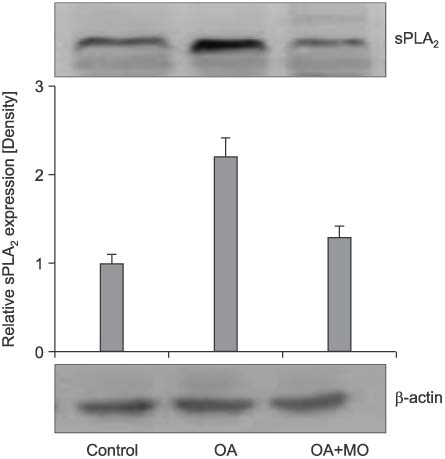Tuberc Respir Dis.
2010 Jun;68(6):334-344. 10.4046/trd.2010.68.6.334.
Moxifloxacin Ameliorates Oleic Acid-induced Acute Lung Injury by Modulation of Neutrophilic Oxidative Stress in Rats
- Affiliations
-
- 1Department of Physiology, Daegu Catholic University School of Medicine, Daegu, Korea. leeym.cu.ac.kr
- KMID: 1458042
- DOI: http://doi.org/10.4046/trd.2010.68.6.334
Abstract
- BACKGROUND
Based on the known immunoregulatory functions of moxifloxacin on phagocytes, the therapeutic effect of moxifloxacin on oleic acid (OA)-induced acute lung injury (ALI) was investigated.
METHODS
Moxifloxacin (10 mg/kg) was given to male Sprague-Dawley rats that had been given oleic acid (OA, 30 microliter) intravenously. Five hours after OA injection, parameters demonstrating ALI were assessed to measure the effects of moxifloxacin on acute lung injury.
RESULTS
The pathological findings of OA-induced ALI's was diminished by moxifloxacin. Through ultrastructural and CeCl3 EM histochemistry, moxifloxacin was confirmed to be effective in decreasing oxidative stress in the lung as well. Indices of ALI, such as lung weight/body weight ratio, protein content in bronchoalveolar lavage fluid, and lung myeloperoxidase were decreased by moxifloxacin. In diaminobenzidine immunohistochemistry, fluorescent immunohistochemistry, and Western blotting of the lung, moxifloxacin had decreased the enhanced expression of secretory phospholipase A2 (sPLA2) by OA.
CONCLUSION
We concluded that moxifloxacin was effective in lessening acute inflammatory pulmonary edema caused by OA, by inhibiting the neutrophilic respiratory burst, which was initiated by the activation of sPLA2.
MeSH Terms
-
Acute Lung Injury
Animals
Aza Compounds
Blotting, Western
Bronchoalveolar Lavage Fluid
Cerium
Free Radicals
Humans
Immunohistochemistry
Lung
Male
Neutrophils
Oleic Acid
Oxidative Stress
Peroxidase
Phagocytes
Phospholipases A2, Secretory
Pulmonary Edema
Quinolines
Rats
Rats, Sprague-Dawley
Respiratory Burst
Aza Compounds
Cerium
Free Radicals
Oleic Acid
Peroxidase
Phospholipases A2, Secretory
Quinolines
Figure
Reference
-
1. Bernard GR, Artigas A, Brigham KL, Carlet J, Falke K, Hudson L, et al. The American-European Consensus Conference on ARDS: definitions, mechanisms, relevant outcomes, and clinical trial coordination. Am J Respir Crit Care Med. 1994. 149:818–824.2. Pruzanski W, Vadas P. Phospholipase A2: a mediator between proximal and distal effectors of inflammation. Immunol Today. 1991. 12:143–146.3. Pittet JF, Mackersie RC, Martin TR, Matthay MA. Biological markers of acute lung injury: prognostic and pathogenetic significance. Am J Respir Crit Care Med. 1997. 155:1187–1205.4. Chenevier-Gobeaux C, Simonneau C, Therond P, Bonnefont-Rousselot D, Poiraudeau S, Ekindjian OG, et al. Implication of cytosolic phospholipase A2 (cPLA2) in the regulation of human synoviocyte NADPH oxidase (Nox2) activity. Life Sci. 2007. 81:1050–1058.5. Dana R, Malech HL, Levy R. The requirement for phospholipase A2 for activation of the assembled NADPH oxidase in human neutrophils. Biochem J. 1994. 297(Pt 1):217–223.6. Schaloske RH, Dennis EA. The phospholipase A2 superfamily and its group numbering system. Biochim Biophys Acta. 2006. 1761:1246–1259.7. Lee YM, Hybertson BM, Cho HG, Terada LS, Cho O, Repine AJ, et al. Platelet-activating factor contributes to acute lung leak in rats given interleukin-1 intratracheally. Am J Physiol Lung Cell Mol Physiol. 2000. 279:L75–L80.8. Martensson J, Jain A, Stole E, Frayer W, Auld PA, Meister A. Inhibition of glutathione synthesis in the newborn rat: a model for endogenously produced oxidative stress. Proc Natl Acad Sci U S A. 1991. 88:9360–9364.9. Furue S, Kuwabara K, Mikawa K, Nishina K, Shiga M, Maekawa N, et al. Crucial role of group IIA phospholipase A(2) in oleic acid-induced acute lung injury in rabbits. Am J Respir Crit Care Med. 1999. 160:1292–1302.10. Werber S, Shalit I, Fabian I, Steuer G, Weiss T, Blau H. Moxifloxacin inhibits cytokine-induced MAP kinase and NF-kappaB activation as well as nitric oxide synthesis in a human respiratory epithelial cell line. J Antimicrob Chemother. 2005. 55:293–300.11. Weiss T, Shalit I, Blau H, Werber S, Halperin D, Levitov A, et al. Anti-inflammatory effects of moxifloxacin on activated human monocytic cells: inhibition of NF-kappaB and mitogen-activated protein kinase activation and of synthesis of proinflammatory cytokines. Antimicrob Agents Chemother. 2004. 48:1974–1982.12. Uriarte SM, Molestina RE, Miller RD, Bernabo J, Farinati A, Eiguchi K, et al. Effects of fluoroquinolones on the migration of human phagocytes through Chlamydia pneumoniae-infected and tumor necrosis factor alpha-stimulated endothelial cells. Antimicrob Agents Chemother. 2004. 48:2538–2543.13. Shalit I, Horev-Azaria L, Fabian I, Blau H, Kariv N, Shechtman I, et al. Immunomodulatory and protective effects of moxifloxacin against Candida albicans-induced bronchopneumonia in mice injected with cyclophosphamide. Antimicrob Agents Chemother. 2002. 46:2442–2449.14. Shiue ST, Thrall RS. Effect of corticosteroid therapy on the acute injury and recovery stage of oleic acid induced lung injury in the rat. Exp Lung Res. 1991. 17:629–638.15. Brown RE, Jarvis KL, Hyland KJ. Protein measurement using bicinchoninic acid: elimination of interfering substances. Anal Biochem. 1989. 180:136–139.16. Goldblum SE, Wu KM, Jay M. Lung myeloperoxidase as a measure of pulmonary leukostasis in rabbits. J Appl Physiol. 1985. 59:1978–1985.17. Hobson J, Wright J, Churg A. Histochemical evidence for generation of active oxygen species on the apical surface of cigarette-smoke-exposed tracheal explants. Am J Pathol. 1991. 139:573–580.18. Matalon S, Ji HL. Oleic acid damages ion transport and promotes alveolar edema: the dark side of healthy living. Am J Respir Crit Care Med. 2005. 171:424–425.19. Lee YM, Kim BY, Park YY. Role of the PLA2-activated neutrophilic oxidative stress in oleic acid-induced acute lung injury. Tuberc Respir Dis. 2010. 68:55–61.20. Williams AC, Galley HF, Webster NR. The effect of moxifloxacin on release of interleukin-8 from human neutrophils. Br J Anaesth. 2001. 87:671–672.21. Zimmermann GS, Neurohr C, Villena-Hermoza H, Hatz R, Behr J. Anti-inflammatory effects of antibacterials on human Bronchial epithelial cells. Respir Res. 2009. 10:89.22. Hand WL, Hand DL, Vasquez Y. Increased polymorphonuclear leukocyte respiratory burst function in type 2 diabetes. Diabetes Res Clin Pract. 2007. 76:44–50.23. Ljungman AG, Tagesson C, Lindahl M. Endotoxin stimulates the expression of group II PLA2 in rat lung in vivo and in isolated perfused lungs. Am J Physiol. 1996. 270.24. Arbibe L, Vial D, Rosinski-Chupin I, Havet N, Huerre M, Vargaftig BB, et al. Endotoxin induces expression of type II phospholipase A2 in macrophages during acute lung injury in guinea pigs: involvement of TNF-alpha in lipopolysaccharide-induced type II phospholipase A2 synthesis. J Immunol. 1997. 159:391–400.25. Lindbom J, Ljungman AG, Lindahl M, Tagesson C. Increased gene expression of novel cytosolic and secretory phospholipase A(2) types in human airway epithelial cells induced by tumor necrosis factor-alpha and IFN-gamma. J Interferon Cytokine Res. 2002. 22:947–955.
- Full Text Links
- Actions
-
Cited
- CITED
-
- Close
- Share
- Similar articles
-
- Role of the PLA2-Activated Neutrophilic Oxidative Stress in Oleic Acid-Induced Acute Lung Injury
- A Study on the Mechanism of Immunomodulating Effects of Moxifloxacin in Oleic Acid-Induced Acute Lung Injury
- Moxifloxacin Alleviates Oleic Acid-provoked Neutrophilic Respiratory Burst in the Rat Lung through the Inhibition of Cytosolic Phospholipase A2
- Presumptive Role of Neutrophilic Oxidative Stress in Oxygen-induced Acute Lung Injury in Rats
- Phospholipase A2 Contributes to Hemorrhage-induced Acute Lung Injury Through Neutrophilic Respiratory Burst







